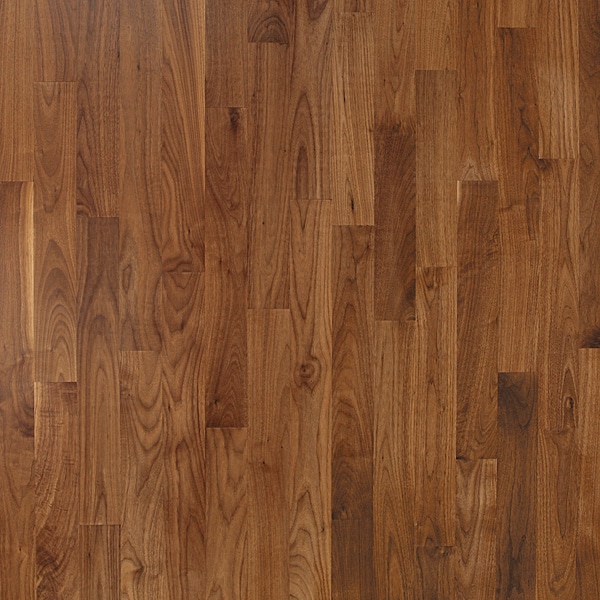
Quick Specs
Common Name(s): Black Walnut
Scientific Name: Juglans nigra
Distribution: Eastern United States
Tree Size: 100-120 ft (30-37 m) tall, 2-3 ft (.6-1 m) trunk diameter
Average Dried Weight: 38 lbs/ft3 (610 kg/m3)
Specific Gravity (Basic, 12% MC): .51, .61
Janka Hardness: 1,010 lbf (4,490 N)
Modulus of Rupture: 14,600 lbf/in2 (100.7 MPa)
Elastic Modulus: 1,680,000 lbf/in2 (11.59 GPa)
Crushing Strength: 7,580 lbf/in2 (52.3 MPa)
Shrinkage: Radial: 5.5%, Tangential: 7.8%, Volumetric: 12.8%, T/R Ratio: 1.4
Walnut Solid Wood Flooring Grades
NWFA-NOFMA CLEAR WALNUT: A flooring product selected for its dark rich coloration and minimal character marks. The face is 100% true heartwood coloration.
Will admit the following and other similar characters: one (1) small tight knot up to 1/4″ (.250”) (6.35mm) in diameter every 3′ (914.4 mm) of length; small tight checks; a minimal number of slight edge defects (indentations); small burls and fine unstained pinworm holes or a thin brown streak 3″ (76.2 mm) long in 2′ (609.3 mm) of length; and threequarters (3/4) tongue, full length of the piece.
NWFA-NOFMA SELECT WALNUT: A flooring product with natural coloration variations found in heartwood and steamed dark sapwood. The steamed sapwood should not show a prominent color contrast to the heartwood.
Will admit the following and similar characters: broken knots up to 3/8″ (.375”) (9.53 mm) in diameter with no loose pieces; narrow slightly open checks; edge defects (indentations) up to 1/16″ (.0625”) (1.59 mm) wide x 1/2″ (.500”) (12.7 mm) long in aggregate for every 2′ (609.6 mm) of length; intermittent machine burn; torn grain (must sand out); pinworm holes two (2) per foot (304.8 mm) of length and/or two (2) flag worm holes per 8′ (2438.4 mm) of length; a slight amount of scant thickness where ends are full thickness; and one-half (1/2) tongue, full length of the piece.
NWFA-NOFMA NO. 1 COMMON WALNUT: A flooring product which may contain prominent color variation between the light sapwood and dark heartwood, along with prominent natural and machine produced characters.
Will admit the following and other similar characters: broken knots, if the unsound open area does not extend through the piece; numerous checks up to 1/16″ (.0625”) (1.59 mm) wide; edge defects (indentations) up to 3/32″ (.09375”) (2.38 mm) wide x 1 1/2″ (38.1 mm) long in aggregate for every 3′ (914.4 mm) of length; occasional solid machine burns; rough face showing minor saw marks; heartwood coloration must be 25% of piece or an quivalent; sapwood may be stained, blotchy or speckled; worm holes, up to 1/8″ (.125”) (3.18 mm) in diameter, one (1) per foot (304.8 mm) of length; pin worm holes, six (6) per foot (304.8 mm) of length; small area of torn grain to 1/16″ (.0625”) (1.59 mm) deep; up to 20″ (508 mm) of scant stock (hit or miss) per 5′ (1524 mm) of length and have full thickness within 3″ (76.2 mm) of ends; and one-quarter (1/4) tongue, full length of the piece.
NWFA-NOFMA NO. 2 COMMON WALNUT: A flooring product which contains sound, natural variations and manufacturing imperfections of the forest product, all imperfections and open characters must be fillable.
Will admit the following and other similar characters: knots and knot holes where openings do not extend through piece; edge defect 1/4″ (.250”) (6.35mm) wide x 1/4″ (.250”) (6.35mm) wide if irregular and will hold filler – not to extend in depth through the tongue and groove engagement; dark machine burns not more than 3/64″ (.0469”) (1.19 mm) deep; prominent open checks not extending through piece; incipient decay which is not softer than surrounding wood; a small un-planed area radiating saw marks; split ends with no movement across the split; an area of torn grain up to 1/8″ (.125”) (3.18 mm) deep x 3″ (76.2 mm) in length for the full width of the piece permitted for every 2’ (609.6 mm) of in length; angled grub worm holes 3/16″ (.1875”) (4.76 mm) x 1/2″ (.500”) (12.7 mm) along with all other worm holes if sound; unlimited sapwood; Occasional scant thickness (hit or miss) on the back of the flooring board the entire length of the piece admitted, providing there is full bearing across the board at some point within three inches of the ends. A limited number of pieces with no tongue admitted.
